
The FIM-92 Stinger is an American man-portable air-defense system (MANPADS) that operates as an infrared homing surface-to-air missile (SAM). It can be adapted to fire from a wide variety of ground vehicles, and from helicopters and drones as the Air-to-Air Stinger (ATAS). It entered service in 1981 and is used by the militaries of the United States and 29 other countries. It is principally manufactured by Raytheon Missiles & Defense and is produced under license by Airbus Defence and Space in Germany and by Roketsan in Turkey.

The 9K32 Strela-2 is a light-weight, shoulder-fired, surface-to-air missile or MANPADS system. It is designed to target aircraft at low altitudes with passive infrared-homing guidance and destroy them with a high-explosive warhead.
The 9K34 Strela-3 is a man-portable air defense missile system (MANPADS) developed in the Soviet Union as a response to the poor performance of the earlier 9K32 Strela-2 system. The missile was largely based on the earlier Strela 2, and thus development proceeded rapidly. The new weapon was accepted into service in the Soviet Army in January 1974.

The M47 Dragon, known as the FGM-77 during development, is an American shoulder-fired, man-portable anti-tank guided missile system. It was phased out of U.S. military service in 2001, in favor of the newer FGM-148 Javelin system.

The RPG-29 "Vampir" is a Soviet reusable rocket-propelled grenade (RPG) launcher. Adopted by the Soviet Army in 1989, it was the last RPG to be adopted by the Soviet military before the fall of the Soviet Union in 1991.

Man-portable air-defense systems are portable surface-to-air missiles. They are guided weapons and are a threat to low-flying aircraft, especially helicopters.

The 9K38 Igla is a Russian/Soviet man-portable infrared homing surface-to-air missile (SAM) system. A simplified, earlier version is known as the 9K310 Igla-1, and the latest variant is the 9K338 Igla-S.
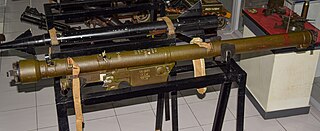
The HN-5 is a family of first generation Chinese man-portable air-defense systems (MANPAD) based on Soviet technology. The HN abbreviation is used to avoid confusion with the HY series anti-ship missiles of the Silkworm missile family. The HN-5 series in Chinese hands has been phased out in front-line and first line reserve units by QW series MANPAD, but still being used by militia units.

The Anza is a series of shoulder-fired, man-portable surface-to-air missiles produced by Pakistan. Guided by an infrared homing seeker, the Anza is used for short range air defence.
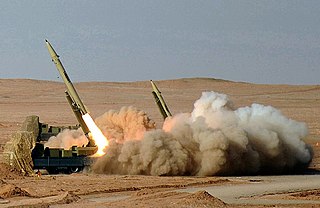
The Fateh-110, also known as NP-110 is an Iranian solid-fueled surface-to-surface ballistic missile produced by Iran's Aerospace Industries Organization since 2002. It is single-stage, road-mobile and can carry a high-explosive warhead of up to 500 kg. Four different versions, the Fateh-110A, 110B, 110D-1 and Fateh-E Mobin were developed with varying accuracy. The latest version, first shown to the public in August 2018 reportedly has a range of 300 km is reportedly more accurate than previous versions.
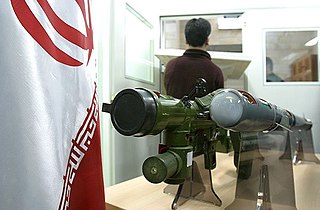
The Misagh-2 is an Iranian man-portable infrared-guided surface-to-air missile. The Misagh-2 is the successor to the Misagh-1. Like its predecessor, the Misagh-2 is based on Chinese technology, and in particular is believed to be an Iranian copy of the Chinese QW-1M MANPADS.

The Fajr-3 is an Iranian heavy 240 mm intermediate-range multiple-launch artillery rocket (MLRS). The Fajr-3 is a license-built copy, with slight modifications, of a North Korean MLRS called the M-1985. The Fajr-3 was introduced in the 1990s and has since been exported to Hamas and Hezbollah.
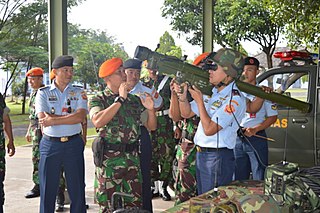
The QW-series are man-portable air-defense systems (MANPADS) developed by the People's Republic of China.
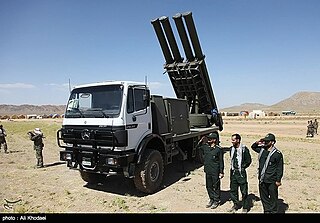
The Fajr-5 is an Iranian 333 mm long-range multiple launch rocket system (MLRS). The Fajr-5 was developed during the 1990s and has since been exported to various armed actors in the Middle East.

The Raad or RAAD is an Iranian wire-guided anti-tank guided missile based on the Soviet 9M14M Malyutka missile. The Raad began mass production in 1988 and was publicly unveiled in 1997. It is manufactured by Parchin Missile Industries, a subsidiary of Iran's Defense Industries Organization.

Hezbollah, a Lebanese Shia Islamist political party and militant group, has an exceptionally strong military wing, thought to be stronger than the Lebanese Army, and equivalent to the armed strength of a medium-sized army. A hybrid force, the group maintains "robust conventional and unconventional military capabilities", and is generally considered to be the most powerful non-state actor in the world.

The Toophan is an Iranian SACLOS anti-tank guided missile reverse-engineered from the American BGM-71 TOW missile. The Toophan 1, an unlicensed copy of the BGM-71A TOW missile, began mass production in 1988 and the Toophan 2, a BGM-71C ITOW variant, was publicly shown in 2000.
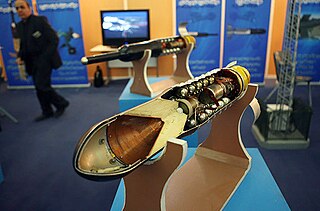
The Saegheh is any of at least eight completely separate Iranian weapons systems: a rocket-propelled grenade (RPG) warhead, an anti-tank guided missile family, a surface-to-surface rocket, a target drone family, an air-to-air missile, a claimed stealth unmanned aerial vehicle, a fighter jet, and an anti-ship cruise missile.
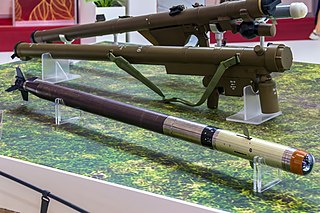
FN-6 or Feinu-6 is a third-generation passive infrared homing (IR) man portable air defence system (MANPADS). Development from HN-5 missile, FN-6 missile is an export-oriented product and China's most advanced surface-to-air missile offered on the international market. Specially designed to engage low-flying targets, it has a range of 6 km and a maximum altitude of 3.8 km. The missile has been exported to Malaysia, Cambodia, Sudan, Pakistan, and Peru, and a variant was incorporated into People's Liberation Army (PLA) service as the HN-6. Based on FN-6, China has several numbers of other MANPADS and other vehicle-based short-range air defense systems.
Iranian influence in Lebanon dates to the 16th century and has grown considerably during the 20th century, first minimally under the Shah through the interchange of elites, specifically in Beirut and then significantly following the Iranian Revolution and Iran's training and funding of Hezbollah. Iran has had a prominent influence in the social services, education, the economy and politics of Lebanon.


















